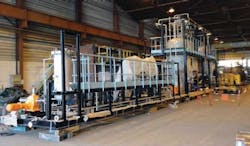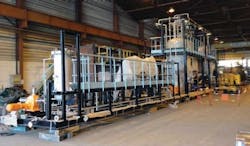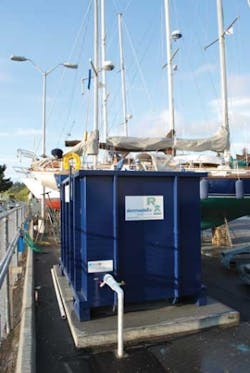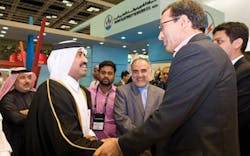Water Briefs
Treatment System Targets Perchlorate in Groundwater
Envirogen Technologies has been awarded a contract by American Pacific Corp. (AMPAC) to provide a large-scale fluidized bed bioreactor (FBR) system for the biodegradation of perchlorate and other constituents from groundwater in the area of a former manufacturing facility in Henderson, NV.
The 1.2 million gallons per day (MGD) capacity system will replace a smaller biological-based system in operation since 2006, and use Envirogen's patented FBR technology in a custom configuration to reduce influent concentrations of perchlorate to non-detectable levels prior to surface discharge. Currently in the design phase, the new treatment system is scheduled for start-up in December 2011.
According to Robert Stark, South Region Vice President for Envirogen, this latest project underscores increasing industry awareness and acceptance of the FBR as a reliable and environmentally sustainable solution to groundwater remediation needs.
"This innovative 'green' technology continues to distinguish itself as the best answer to heavily perchlorate-laden groundwater in both remediation and drinking water applications. In this instance, we are targeting perchlorate as the primary contaminant, but are able to remove both chlorate and nitrate with the same process," Stark said.
The FBR systems are "designed to provide robust treatment in a small footprint, with acceptable waste rates and reduced energy and chemical consumption. The technology's flexibility to handle multiple constituents and varying flow characteristics also bodes well for its potential to treat other significant emerging contaminants such as selenium, hexavalent chromium or chlorinated solvents," he said.
Perchlorate is a highly soluble anion that is used in the manufacture of solid rocket propellant, fireworks, road flares, explosives and other products. Envirogen's FBR is a fixed-film bioreactor in which biological media is suspended, or fluidized, within the reactor vessel by the upward flow of water through the system. The suspended media provides a large surface area for microbial growth and allows a biomass density several times greater than that of other bioreactor designs under similar loading conditions. Microorganisms in the reactor completely destroy influent perchlorate and other targeted contaminants under anoxic conditions, without generating hazardous waste by-products.
The new system being designed and built for AMPAC will consist of three FBRs and an H-120 biofilter for odor control. The facility will remove up to 500 ppm of perchlorate in the groundwater to non-detectable levels and, depending on the load, treat up to 800 gpm. Envirogen will also provide installation oversight and customer support through the training and start-up phases of system implementation.
Company Develops 'Cold Combustion' Waste Treatment Process
Innoveox has developed a new system called Supercritical Water Oxidation to treat all organic waste. The treated effluent contains no metals or minerals, and it can be discharged directly into the natural environment. The company claims the process is less expensive and more efficient than traditional treatment techniques.
The system was introduced at the Americana trade show in Montreal earlier this year. Major waste treatment companies, oil and gas corporations and global engineering companies have already passed along positive feedback by sending samples to Innoveox to be tested.
The compact Supercritical Water Oxidation system can be installed in high-risk areas to reduce the need to transport hazardous waste.
Supercritical Water Oxidation does not produce or transfer any pollution or toxic by-products. It consists of "cold" combustion of organic matter, which it destroys, leaving only water. The waste, even if toxic, is subjected to a temperature of between 350°C and 550°C at a pressure of 221 bars, with oxygen present. This technique is particularly suited to liquid waste that is too concentrated to be broken down biologically or too diluted to be incinerated efficiently.
All organic industrial waste can be treated: hazardous waste like pesticides, PCBs, used oils and solvents, petroleum waste or complex, corrosive, refractory and even explosive waste. This technique can also be used to treat the wastewater from water treatment plants. It has a field of application that extends to nuclear and military fields, particularly to neutralize chemical weapons.
The process also permits recovery of minerals and metals for recycling. Another of its strengths is the speed of treatment (reaction lasting about one minute) and the system's compactness. It can be installed directly in high-risk areas to avoid transferring dangerous waste.
Innoveox has the world exclusivity on this French technology. Applications are currently under development in various fields. In aerospace, for example, carbon fiber can be recycled with high added value in composite materials instead of incinerating it. In the biomass sector, this technique will be used to produce energy, bio-fuels and raw materials for green chemistry.
Stormwater Treatment Company wins Environmental Award
StormwateRx LLC, a provider of industrial stormwater treatment and filtration systems, was honored in May with an Environmental Excellence Award from the Association of Washington Business (AWB). The company won the 2011 Green Enterprise & Technology Award for its systems that help industrial sites manage and treat stormwater runoff and prevent pollutants from entering local waterways.
In addition, StormwateRx customer Seaview Boatyard received an AWB award for Leading Environmental Practices for its implementation of green technologies and practices, including stormwater treatment, that have helped the yard become one of the most environmentally progressive boatyards in the Northwest.
The StormwateRx Aquip® enhanced filtration systems installed at Seaview are specifically designed to remove known boatyard pollutants such as copper, lead, zinc, and total suspended solids (TSS).
"Whether it's organic farming, recycling or educating the public about best environmental practices, the companies we celebrate today have become industry leaders for finding innovative, sustainable solutions to ongoing challenges," said AWB President Don Brunell.
StormwateRx designs, manufactures and installs stormwater treatment systems for industrial sites across the United States and Canada. The company also has developed a series of Industry Remedies documents, available on its website, that include best practices and product configurations that address the unique environmental concerns of various industries.
"We are honored to receive this award from the AWB," said Calvin Noling, president and CEO of StormwateRx. "Winning an Environmental Excellence award in the state of Washington, while also seeing one of our customers receive honors for their own environmental leadership, holds particular significance for us."
With a number of environmentally sensitive areas, major waterways and a relatively high amount of annual rainfall, the state of Washington has implemented some of the most protective stormwater benchmarks in North America. StormwateRx has more than 30 installations in Washington alone, with the capacity to treat five million gallons of polluted stormwater per day. These systems are removing thousands of pounds of toxic pollutants each year to protect Puget Sound and other Washington waterways.
More information on the company's systems can be found at www.stormwaterx.com.
Treatment System to Remove Selenium from Power Plant Wastewater
American Electric Power (AEP) is installing GE's ABMet® wastewater bioreactor system at the utility's Mountaineer coal-fueled power plant in New Haven, WV. The proprietary biological treatment system uses a special molasses-based product as a nutrient for microbes that reduce selenium, a constituent found in many coal-fired power plant water emissions.
GE's ABMet technology uses special strains of common, non-pathogenic microbes that facilitate the conversion of soluble selenium into elemental selenium, which is removed from the system during periodic backwashing. The microbes, which are fed the molasses-based nutrient, are seeded in a bed of activated carbon that acts as a growth medium for the microbes to create a biofilm. Selenium-laden wastewater passes through this bioreactor and a reduction reaction occurs. Other than the addition of the nutrient, the system will be self-sustaining once it is established.
Selenium is an element found in coal that is not consumed in the combustion process and typically can be found in several of a plant's post-combustion waste streams.
AEP is installing GE's system to allow its 1,300-megawatt Mountaineer generating station to comply with a new discharge limit for selenium. Construction of AEP's treatment facility began in July 2010. The system is scheduled to become operational by the end of 2011.
AEP is the third U.S. utility to deploy the wastewater treatment process. The installation is GE's fifth in the coal-fired power industry and 10th overall. While GE's process also is capable of removing other constituents such as nitrate and a variety of metals, AEP's focus at Mountaineer is selenium reduction.
"AEP's deployment of our ABMet technology underscores the importance of partnerships between coal plant operators and service providers to develop and commercialize the latest cleaner energy and water technologies," said Jeff Connelly, vice president, engineered systems–water and process technologies for GE Power & Water. "If coal is going to continue serving as a major energy source, it is essential for the industry to support the deployment of new technologies that can help to dramatically reduce its environmental footprint."
The team of GE, Indianapolis-based Bowen Engineering, HDR Engineering of Omaha, Neb., and River Consulting of Columbus, Ohio, is supporting AEP's project team under a single agreement.
The U.S. Environmental Protection Agency first established a national water quality standard for selenium in 1987. In 2011, the agency is expected to propose a revised limit based on current selenium levels in fish and also is developing revised effluent limitation guidelines for the steam-electric power industry that are expected to be released in draft form in 2012.
EPA to Begin Soil Cleanup at Scrap Iron Superfund Site
The U.S. Environmental Protection Agency has announced plans to excavate contaminated soil on the Ellenville Scrap Iron and Metal Superfund site in Ellenville, NY, and move it to a landfill on the property. The landfill will then be securely capped to prevent contaminants from leaching out of the landfill into the groundwater.
The excavation of the soil, which is contaminated with hazardous chemicals and metals, is the first part of a site cleanup plan EPA selected in September 2010. Any of the excavated soil or materials that are characterized as hazardous waste will be shipped off-site for proper disposal.
"EPA is committed to cleaning up the Ellenville Scrap Iron and Metal Superfund site," said EPA Regional Administrator Judith Enck. "Containing and isolating contaminated soil at this site is important to protect people from potential exposure to harmful contaminants and to protect the underlying groundwater."
EPA will perform its work at the Ellenville site in partnership with the U.S. Army Corps of Engineers and the New York State Department of Environmental Conservation (NYSDEC). The cleanup, which is expected to cost about $8 million, is being paid for by EPA, with NYSDEC contributing 10 percent of the funding. Cleanup work at the site is expected to be completed this fall. No financially viable potentially responsible parties exist to perform or fund the cleanup of the Ellenville site.
EPA will excavate contaminated soil from six different areas at the site, consolidate the soil on the landfill portion of the site and then securely cap the landfill. EPA will also install a series of additional wells to monitor groundwater around the site to make sure it remains free of contaminants.
For more information about the site, visit: http://www.epa.gov/region02/superfund/npl/ellenville/.
Infiltrative Chambers Help Recharge Groundwater at Warehouse
Polar Beverages, the country's largest independent soft-drink bottler that mainly distributes its products in New England and upstate New York, has a manufacturing facility in Auburn, MA, as well as several warehouses in the area. As the company faced the need for increased storage space, Polar leased a large warehouse in Auburn with an eye toward not only expanding its storage capacity but also consolidating most of its warehouses in this new location.
At the Polar Beverages warehouse in Auburn, MA, an underground infiltration chamber system was installed to handle stormwater runoff from a large rooftop area.
The engineers at Land Planning Inc. designed a 112,500-square-foot addition to the existing 168,550-square-foot building, increasing the amount of impervious surfaces onsite. They also had to design a stormwater system that would infiltrate clean rooftop runoff back into the ground, recharging the groundwater. The amount of post-development runoff recharged back into the ground needed to be equal to or greater than the pre-development amount, as required by local regulations.
While the engineers had enough space for capturing stormwater runoff from the parking lot and other ground-level surfaces in an above-ground detention system, the site had no area for an infiltration system. Land Planning specialists decided to use an underground infiltration chamber system provided by Cultec, a company whose systems they had specified in the past.
"We needed a chamber that would have enough capacity to handle the runoff from a large rooftop area," said Norman G. Hill, project engineer and president of Land Planning. "We could not use perforated pipes in this case because the pipes that could fit in the available space did not have enough storage capacity."
For the project, the engineers selected Cultec's Recharger® V8™, the company's largest capacity plastic chamber able to hold a minimum of about 100 cubic feet of water when installed according to instructions. It is 32 inches high and 60 inches wide, with a bare chamber capacity of 8.68 cubic feet per linear foot. Located under the parking lot, the system captures rooftop runoff and slowly infiltrates it into the ground, replenishing the surrounding soil and aquifer.
The stormwater runoff from the parking lot follows to a Stormceptor® unit for filtration and then the excess stormwater is sent into an extended detention wetland located beyond the parking lot. Cultec's system occupies 9,000 square feet of the 19.2-acre warehouse site, offering approximately 21,946 cubic feet of storage capacity.
The installation began with excavating a bed, laying filter fabric along the sides and the bottom and adding a layer of crushed stone. After the V8 chambers were in place they were backfilled with stone, covered with a layer of fabric designed to reinforce the system to better bear traffic loads, and prepared for asphalt.
"The installation process took less than one week, which was very reasonable for such a large system," said Jeffrey Murray with Patriot Environmental Corp., the project contractor. "I was happy with the ease of installation as well as with the fact that Cultec's representative provided all the necessary site-specific sketches and field assistance during the installation."
Past IWW Issues



